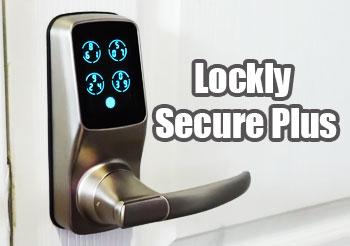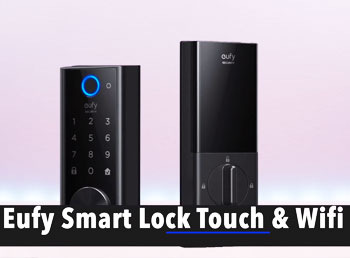Smart locks are becoming increasingly popular as people look for more convenient and secure ways to access their homes. Two of the top brands in smart locks are Lockly and Eufy.
But which one is better? This comprehensive guide examines the key features, pros, cons, and differences between Lockly and Eufy smart locks to help you decide which is best for your needs.
A Brief Comparison Table
| Feature | Lockly | Eufy |
| Installation | Easy DIY installation | Requires professional installation |
| Connectivity | WiFi, Bluetooth, Apple HomeKit | WiFi, Bluetooth, Alexa, Google Assistant |
| Unlocking Methods | Fingerprint, keypad code, app, key | Fingerprint, facial recognition, keypad code, app |
| Battery | 4 AA batteries last up to 1 year | Rechargeable battery lasts up to 6 months |
| Design | Sleek all-touch screen | More traditional deadbolt design |
| Smart Features | Auto-lock, activity alerts | Auto-lock, knock to open |
| Remote Access | Yes | Yes |
| Voice Control | Via HomeKit, Alexa, Google Assistant | Via Alexa, Google Assistant |
| Door Sensors | Sold separately | Included |
| Price | $199 – $349 | $169 – $229 |
Overview of Lockly

Lockly is a newer smart lock brand that focuses on innovative technology and ease of use. Their locks stand out with an all-glass touchscreen keypad and minimalist design. Here are some of Lockly’s key features:
- Easy DIY installation: Lockly has a simple retrofit installation that works on most standard deadbolts. No wiring or professional installation required.
- Multiple unlock methods: You can unlock with fingerprint, a custom code on the keypad, the Lockly app, or a physical key. It stores up to 99 fingerprints and 25 codes.
- HomeKit enabled: Lockly works with Apple HomeKit, allowing you to control your lock with Siri voice commands.
- Activity alerts: The app sends notifications for system events like successful unlocks. You’ll know if someone enters with their fingerprint or a code.
- Auto-lock: Lockly automatically re-locks after a set time period. You can also lock it remotely from the app.
- Powered by batteries: It runs on 4 AA batteries that last around 1 year before needing replacement. There are no batteries to recharge.
- Sleek design: The all-glass touchscreen looks modern and seamless. The lock fits a standard deadbolt door prep.
- Guest access: You can create custom codes for visitors or service providers that automatically expire after a set time.
- Weather resistance: Lockly is rated for both hot and cold climates. It can handle temperatures from -4°F to 140°F.
Overview of Eufy
Eufy is Anker’s smart home brand. Their smart locks focus on advanced technology like facial recognition and integration with voice assistants. Here are some standout features of Eufy:
- Professional installation: Eufy recommends professional installation to ensure proper wiring and alignment. This adds to upfront costs.
- Facial recognition: Along with fingerprints, you can also unlock Eufy using its face recognition camera. It stores up to 30 face profiles.
- Voice assistant integration: Eufy works with both Amazon Alexa and Google Assistant for voice control. You can lock/unlock via voice commands.
- “Knock to Open”: You can tap the knock sensor instead of using your fingerprint or code to unlock the door.
- Rechargeable battery: The built-in battery lasts around 6 months before needing a recharge. Much less battery maintenance than Lockly.
- Auto-lock and alerts: Like Lockly, Eufy will auto-lock and send app notifications for system activity.
- Traditional deadbolt design: Eufy has a more familiar deadbolt style. The touchscreen is separate from the thumbturn and deadbolt.
- Remote access: You can control your Eufy smart lock from anywhere via the mobile app.
- Includes door/window sensors: Entry sensors are included to trigger automatic locking when you leave and unlocking when you arrive home.
Also Read: Comaparison Between Kwikset 955 and 917
Detailed Comparison Between Lockly and Eufy
Now that we’ve covered the basics of Lockly and Eufy smart locks, here is a more in-depth look at how the two compare across 7 key factors:

- Installation and Compatibility
Lockly uses a simple retrofit installation that works on most standard deadbolts without re-wiring. It can be easily installed DIY in under 10 minutes. However, it is not compatible with some smart home systems like ADT Pulse.
Eufy requires full replacement of the deadbolt and professional installation for proper alignment and wiring. This adds cost, but makes it more universally compatible with smart home ecosystems.
Overall, Lockly is the better choice if you want a simplified install. Go with Eufy if broader smart home integration is important.
- Unlocking Methods
Lockly allows unlocking via fingerprint, custom keypad code, the app, or physical key. It stores up to 99 fingerprints and 25 keypad codes. There is no facial recognition.
Eufy offers fingerprint, facial recognition, custom code, app, and physical key unlocking. It stores up to 30 facial profiles and 50 fingerprints. The facial recognition uses AI for accuracy.
Eufy pulls ahead with the addition of facial recognition, which many users find more convenient than fingerprint scanning. Both offer robust fingerprint and code storage capacity.
- Power and Battery
Lockly runs on 4 AA batteries that last around 1 year before replacement. There is no battery charging required.
Eufy has an integrated rechargeable lithium-ion battery that lasts approximately 6 months before needing a recharge. You must periodically plug it in.
For pure battery convenience, Lockly wins with long-lasting AA batteries and no recharging. But Eufy’s rechargeable battery means you generate less plastic waste from fewer battery replacements.
- Smart Features
Lockly and Eufy both provide standard smart lock features like auto-lock, remote access via app, and activity notifications.
However, Eufy adds a few extra smart conveniences like voice assistant integration and the ability to knock on the door sensor to unlock. Lockly lacks native support for Amazon Alexa or Google Assistant.
Eufy pulls ahead in smart features and integration with its wider voice assistant support and knock unlocking. But Lockly covers the core essentials.
Also Watch This Video:
- Design
Lockly has an elegant all-glass touchscreen that looks sleek and modern. The minimalist design seamlessly fits on most doors.
Eufy uses a more traditional, separate deadbolt and touchscreen design. The metal deadbolt may match some homes better than Lockly’s all-glass look.
For those wanting a contemporary style, Lockly’s unified touchscreen has an appealing aesthetic. Eufy looks more like a standard deadbolt but could blend in easier. This one comes down to personal taste.
- Door Sensors
Lockly does not come with any entry sensors. You need to purchase them separately if you want capabilities like automatically locking when you leave home.
Eufy includes a set of door/window sensors in the box. These allow you to set up features like locking on exit and unlocking when you arrive based on the sensors.
Eufy is the clear winner when it comes to included sensors. Lockly’s lack of entry sensors out of the box results in missing out on some key features.
- Pricing
Lockly smart locks range from $199-$349 depending on the model. There are no required subscriptions.
Eufy products cost between $169-$229. There are also no monthly fees required.
Eufy wins on price with generally lower prices across comparable models. However, promos and sales can alter pricing for either brand periodically.
- Remote Access and Activity Alerts
Both Lockly and Eufy provide reliable remote access from your smartphone to lock or unlock the door. They also give activity notifications for locks, unlocks, low battery, and other events.
This is essentially a tie when it comes to these smart lock basics. The app experience is very similar across the brands.
Also Read: Comaparison Between the Lockly Secure Pro and Secure Plus
Frequently Asked Questions (FAQs)
No, LOCKLY is not a Chinese company. LOCKLY was founded in California in 2018 and their products are designed and assembled in the USA. While some components may be sourced internationally, LOCKLY is considered an American smart home technology company.
For most homeowners, LOCKLY provides an excellent balance of security, convenience, and ease of use. The ability to unlock with a fingerprint or code, combined with phone app access and auto-lock makes access seamless. LOCKLYs are also easy to install yourself without re-wiring. The upfront cost pays for itself over time in security and flexibility. However, you need to buy entry sensors separately to enable auto lock/unlock based on your proximity.
There is no definitive “best” door lock overall. The right lock depends on your priorities. Keypad locks like LOCKLY provide flexible access, while Eufy offers facial recognition. Smart locks are convenient but more expensive than traditional deadbolts. Grade 1 and Grade 2 locks offer maximum residential security. Consider your access needs, features, budget, and style preferences.
According to many experts and customer reviews, the August Wi-Fi Smart Lock is one of the best keyless door locks available. It is very easy to install and use with your phone, has auto-unlock capabilities as you approach, and securely encrypts all WiFi communications. Alternatives like the Schlage Encode or Yale Assure SL are also excellent keyless smart locks with touchscreens and advanced features.
Also Read: Comparison Between Ultraloq and Eufy
Final Thoughts
When choosing between Lockly and Eufy, there are valid reasons to pick either brand. Lockly stands out for its incredibly easy DIY installation, sleek aesthetic, and long-lasting batteries.
Eufy counters with facial recognition, broader smart home support, included door sensors, and competitive pricing.
Ultimately, Lockly is ideal if you want a contemporary keypad lock that’s simple to install. For advanced features and seamless integration, Eufy edges out Lockly.
But both provide reliable smart access that enhances convenience and security over a traditional deadbolt. Carefully weigh the pros and cons before picking the smart lock that fulfills your needs.
